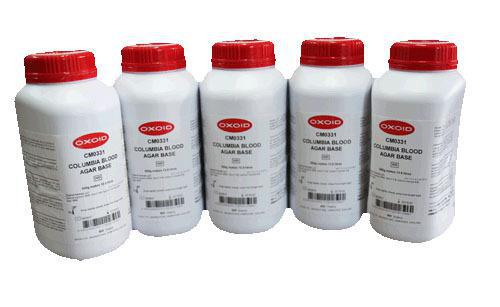Oxoid 念珠菌显色琼脂培养基 CM1002B CHROMOGENIC CANDIDA AGAR
BRILLIANCE CANDIDA AGAR
CODE: CM1002
Brilliance™ Candida Agar (formerly Oxoid Chromogenic Candida Agar (OCCA)) is a selective diffrential medium for the rapid isolation and identification of clinically important Candida species.
Brilliance™ 念珠菌琼脂(原 Oxoid 显色念珠菌琼脂 (OCCA))是一种选择性差异培养基,用于快速分离和鉴定临床上重要的念珠菌种类。
| Typical Formula* |
gm/litre |
| Peptone |
4.0 |
| Chromogenic mix |
13.6 |
| Agar |
13.6 |
| pH 6.0 ± 0.2 @ 25°C |
* Adjusted as required to meet performance standards
BRILLIANCE CANDIDA SELECTIVE SUPPLEMENT
Code: SR0231
| Vial Contents (each vial is sufficient for 500ml of medium) |
per vial
|
per litre
|
| Chloramphenicol |
250mg |
500mg |
Directions
Suspend 15.6g in 500ml of distilled water. Add 1 vial of Brilliance Candida Selective Supplement reconstituted as directed. Mix well and bring to the boil with frequent agitation. DO NOT AUTOCLAVE. Cool the medium to 45°C and pour into sterile Petri dishes.
方向
将 15.6g 悬浮在 500ml 蒸馏水中。 添加 1 瓶 Brilliance 念珠菌选择性补充剂,按照指示重新配制。 充分混合并经常搅拌煮沸。 不要高压灭菌。 将培养基冷却至 45°C,倒入无菌培养皿中。
Description
Brilliance Candida Agar allows the differentiation of Candida albicans and Candida tropicalis from other species of Candida within 48 hours. This is important because rapid identification has been shown to have an impact on the morbidity, mortality, and duration of hospitalization. However, conventional identification of Candida spp. is based on a time-consuming and extensive series of tests, e.g. carbohydrate fermentation and assimilation, growth at 37°C and 42°C, colony and cell morphology and the ability to form germ tubes.
描述
Brilliance 念珠菌琼脂可在 48 小时内区分白色念珠菌和热带念珠菌与其他念珠菌。 这很重要,因为快速识别已被证明对发病率、死亡率和住院时间有影响。 然而,念珠菌属的常规鉴定。 基于一系列耗时且广泛的测试,例如 碳水化合物发酵和同化、在 37°C 和 42°C 下的生长、菌落和细胞形态以及形成胚管的能力。
Serious infections due to Candida species are becoming increasingly prevalent. This poses particular problems because of the increasing incidence of non-albicans spp. and the emergence of non-albicans isolates resistant to both amphotericin B and the newer azoles1. Candida species are the fourth most commonly encountered nosocomial pathogens in bloodstream infections in the United States, and candidiasis is associated with mortality rates as high as 60% in immuno-suppressed patients.
Of the Candida spp. encountered in clinical practice, Candida albicans is the most common, and this species is usually susceptible to the azole group of antifungal agents. However, it is the shift toward the isolation of more azole-tolerant species, such as Candida glabrata, Candida tropicalis, and Candida krusei, due to the increasing use of itraconazole and fluconazole as the antifungal drugs of first choice for candidiasis, which is causing greatest concern. Rapid identification of the Candida spp. causing infection is, therefore, critical for the clinician in determining the correct antifungal therapy2.
For Candida species involved in bloodstream infections on ICUs, it was shown by Ibrahim et al.3 that initial therapy was inadequate in 95% of the cases because no antifungal agent was administered. Due to this inadequacy in the initial treatment, a mortality rate of about 60% was observed in the patient group with Candida infections. Hence, early recognition of a Candida infection would help a clinician to select proper treatment. Combined with rapid identification of the causative organism, this treatment could be optimized to include a non-azole group anti-fungal agent, if required, at an early stage of the infection.
由念珠菌引起的严重感染正变得越来越普遍。由于非白色念珠菌属的发病率不断增加,这带来了特别的问题。以及对两性霉素 B 和较新的唑类均耐药的非白色念珠菌分离株的出现。念珠菌属是美国血流感染中第四常见的院内病原体,念珠菌病与免疫抑制患者的死亡率高达 60% 相关。
念珠菌属。在临床实践中,白色念珠菌最为常见,该菌种通常对唑类抗真菌药物敏感。然而,由于越来越多地使用伊曲康唑和氟康唑作为治疗念珠菌病的首选抗真菌药物,导致越来越多的对唑类耐受的物种(如光滑念珠菌、热带念珠菌和克氏念珠菌)的分离转向最大的担忧。快速鉴定念珠菌属。因此,引起感染对于临床医生确定正确的抗真菌治疗至关重要2。
对于 ICU 中涉及血流感染的念珠菌属物种,Ibrahim 等人 3 表明,95% 的病例初始治疗不充分,因为没有给予抗真菌剂。由于初始治疗的不足,在念珠菌感染患者组中观察到约 60% 的死亡率。因此,早期识别念珠菌感染将有助于临床医生选择适当的治疗方法。结合快速识别致病微生物,这种治疗可以优化,在感染的早期阶段根据需要加入非唑类抗真菌剂。
Brilliance Candida Agar incorporates two chromogens that indicate the presence of the target enzymes:
- X-NAG (5-bromo-4-chloro-3-indolyl N acetyl ß-D-glucosaminide) detects the activity of hexosaminidase.
- BCIP (5-bromo-6-chloro-3-indolyl phosphate p-toluidine salt) detects alkaline phosphatase activity.
The typical enzyme patterns of Candida spp. are shown in Table 1. An opaque agent has been incorporated into the formulation to improve the colour definition on the agar. The broad-spectrum antibacterial agent, chloramphenicol, is added to the agar at 500mg/l to inhibit bacterial growth on the plates.
Technique
Good laboratory practices for the appropriate collection and transport of specimens should be followed. Clinical specimens should be inoculated directly onto the agar. Incubate plates aerobically at 30°C. Inspect for the growth of Candida spp. at 24, 48 and 72 hours.
Table 1: Table of expected reactions on Brilliance Candida Agar
| Chromogen: Enzyme: |
X-NAG |
BCIP
Alkaline phosphatase
|
Typical colony appearance
|
| C. tropicalis |
+
|
Dark blue
|
|
| C. albicans C. dubliniensis |
+
|
Green ‡
|
|
| C. krusei |
+
|
Dry, irregular pink-brown
|
|
| C. glabrata C. kefyr C. parapsilosis C. lusitaniae |
Variable
|
Beige/yellow/ brown †
|
Notes:
‡ The green colour of Candida albicans and Candida dubliniensis is caused by the same chromogenic reaction as the dark blue colour of Candida tropicalis. However, other reactions caused by the medium cause the colonies to appear green.
† Candida glabrata, Candida kefyr, Candida parapsilosis and Candida lusitaniae appear as a variety of beige/brown/yellow colours, due to the mixture of natural pigmentation and some alkaline phosphatase activity. Experienced users may be able to differentiate these species by colour and colony morphology.
For further instructions on the use and interpretation of Brilliance Candida Agar, simply download the data sheet (643KB) in PDF format. Please confirm prepared media codes with your local supplier.
Storage conditions and Shelf Life
Brilliance Candida Agar Base must be stored tightly capped in the original container at 10-30°C. Brilliance Candida Selective Supplement must be stored at 2-8°C. When stored as directed the unopened products will remain stable until the expiry date printed on the containers.
Prepared medium may be stored for up to 2 weeks at 2-8°C.
Appearance
Dehydrated medium: straw coloured, free-flowing powder
Prepared medium: cream coloured opaque gel
Quality control
| Positive controls: | Expected results |
| Candida albicans ATCC®10231 * | Good growth; green colonies |
| Candida krusei ATCC®6258 | Good growth; dry, irregular pink-brown colonies |
| Negative control: | |
| Escherichia coli ATCC® 25922 * | Inhibited |
* This organism is available as a Culti-Loop®
References
1. Sheehan, D. J. et al. (1999) Current and Emerging Azole Antifungal Agents Clinical Microbiology Reviews, 12(1): 40-79
2. Odds, F. C. (1988) Candida and candidosis, 2nd ed. Baillière Tindall, London, England.
3. Ibrahim E.H. et al. (2001) The influence of inadequate antimicrobial treatment of bloodstream infections on patient outcomes in the ICU setting. Chest, 118(1):146-55

